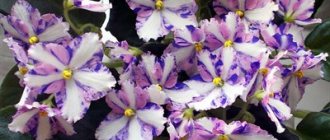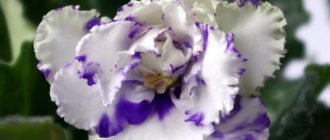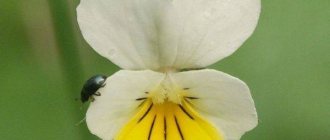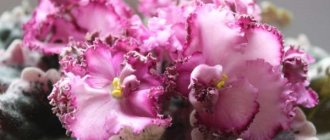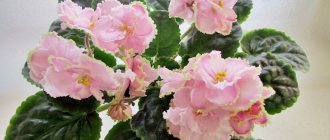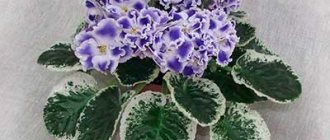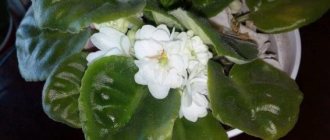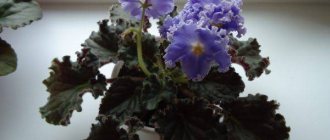In the short time that has passed since the discovery of Saintpaulia, the tropical beauty has managed to win the trust and love of the entire world community of flower growers involved in breeding and growing indoor plants.
Excellent decorative properties with a relatively small size, rapid growth and a variety of colors have allowed the violet to take its rightful place in home collections. And its unpretentious nature with regard to maintenance conditions was especially liked by flower growers, because even a novice amateur, relying on the advice of experts, can cope with caring for Saintpaulia.
For each Uzambara violet, its life processes are special, which in turn determine the basic rules for keeping a tropical beauty in indoor culture.
In most cases, care methods are standard for representatives of the Saintpaulia genus , but there are also all sorts of nuances that must be taken into account to preserve the health and decorative appearance of the violet.
From the innumerable number of varieties of violets, each gardener can select those specimens that will suit his taste and the direction of the collection.
Among the varieties of domestic selection, one can highlight the simple-care Saintpaulia “ND Smuglyanka” , popular due to its spectacular colors.
Description of the tricolor violet and its flowers (with photo)
Synonyms for tricolor violet: pansy, Ivan da Marya, tricolor, little brothers. The plant is found on forest edges, clearings, meadows among shrubs, on the outskirts of fields in the forest and forest-steppe zones of Eurasia.
Botanical characteristics: annual herbaceous plant 10-40 cm high with a thin taproot, weakly branched. The stem is simple or branched, erect, hollow. Leaves are alternate, glabrous, simple; stem ones are sessile, lower ones are petiolate. Tricolor violet flowers are single, irregular, on long peduncles.
Pay attention to the photo, the flowers of the tricolor violet are dark purple at the top and yellow at the bottom.
The fruits are elongated, ovoid, tricuspid capsules. Blooms in July - August.
Trending Wisteria for the middle zone: dreams come true!
Growing conditions. Unpretentious, but prefers loose, fertile soils.
Usage. Can be used to decorate forest areas and rock gardens. A popular medicinal plant in folk medicine.
Varieties. The species was introduced into cultivation a very long time ago, more than 2000 years ago, and during this time many varieties were created both directly using this species and by crossing it with other species. According to the description, the tricolor violet is most similar to the hybrids of Wittrock violet (V. x wittrockiana).
Currently, it can be difficult to determine which specific species a particular variety belongs to, since it is impossible to trace the origin of many of them, so this species is usually classified as small-flowered varieties that are similar in appearance to wild violet tricolor.
"Hortensis " - numerous, small, purple flowers with an orange eye, spreading bush.
“E.A. Bowles" ("EA Bowles"), or "Bowles Black" ("Bowles Black") - the color of the flowers is black and purple.
The violet tricolor is the official symbol of the city of Athens and Emperor Napoleon.
Features of life processes
According to the author’s description, “ND Smuglyanka” belongs to the group of slow varieties suitable for patient gardeners. Many life processes in Saintpaulia take a longer period than in other varieties, and the manifestation of varietal characteristics increases with age.
Development in indoor culture
When growing “ND Smuglyanka”, you should remember that the violet, according to the varietal description, is declared as a plant with a delay , that is, it does not exhibit characteristic signs immediately, but as the specimen matures.
This means that the terry structure of the corolla, its diameter, as well as the white edge of the petals will intensify from flowering to flowering.
You should not reject the variety after the first buds - you need to be patient and wait a little.
The variety is ideal for growing in home collections and as a first specimen for beginning amateur violet growers:
- very unpretentious in terms of growing conditions and care methods;
- develops quite harmoniously;
- independently forms leaf rosettes with a nice configuration;
- blooms in spectacular bouquets.
The violet also does not begin blooming in a bouquet right away; first, several individual buds bloom. During the first flowering, the corollas may lose their decorative appearance a little as they age, lowering the heads down.
ADVICE! When grown with wick irrigation, the rosette can reach significant sizes. To get a compact silhouette, you should remove the bottom row of leaves from a young specimen, replant the plant and remove the buds several times in a row, preventing them from blooming. Under such conditions, it will be possible to grow new rows of not very large leaves.
Time for rosette formation to adulthood
When obtaining young “ND Smuglyanka” violets using the method of propagation by leaf cuttings, one should take into account the varietal slow development of the mature children. to bloom, that is, be considered an adult plant, no earlier than after 10 - 11 months.
An adult plant is considered to be 10-11 months old.
If the bush is formed by rooting a finished baby from the mother plant, then the growing process will end a little faster - the baby is already formed, all that remains is to grow leaf tiers and lay buds.
Reproduction methods and features
Flower growers, wanting to get a young Saintpaulia from their favorite variety, use one of two suitable propagation methods:
- separate the finished shoot from the adult specimen and root it in its flowerpot;
- wait for the formation of young children on the prepared leaf cuttings and root them in due time.
Violets should not be propagated by seed , since almost all Saintpaulia varieties are hybrid varieties that do not retain varietal characteristics during sexual propagation.
Repetition of varietal characteristics is guaranteed when the plant is rejuvenated.
Nuances of flowering at different temperatures
The formation of buds in optimal temperature conditions leads to lush bouquet flowering .
CAREFULLY! When violets bloom in conditions of low temperatures, the white border on the edge of the petals appears more strongly, sometimes the flower can become completely white.
The coincidence of the moment of flowering with intense heat can postpone this phase of violet life indefinitely or deform and reduce the blooming corollas.
Characteristic features of peduncles
Violet forms fairly strong flower stalks that easily support lush flowers in an upright position. But during the first flowering, when the formation of significant bouquets is not yet possible, the flower stalks can gradually fall apart, which leads to drooping corollas.
Flowering type
According to the author's description, violet belongs to the bouquet type of flowering. But this is achieved not at the first laying of buds, but gradually, from flowering to flowering, along with the maturation of the plant.
Bud lifespan
With an optimal microclimate and proper care, Saintpaulia can continue flowering for up to three months. At the same time, the decorative effect of a single corolla is preserved for up to one month.
Graceful violet in the garden
Synonyms. The violet is elegant, the violet is thin.
Distribution area. Balkans, Pyrenees, Asia Minor.
Graceful violet is a perennial plant 10-20 cm high with erect stems. The leaves are coarsely toothed. Flowers up to 4 cm, bluish-lilac or yellow. Blooms from spring to autumn.
In the garden, graceful violet is grown in sun or partial shade, on structured, well-drained, moderately moist, nutritious soils.
Usage. Used to decorate rock gardens.
Varieties of graceful violet and their photos:
"Lord Nelson" - flowers are dark purple, almost black.
"Moonlight" - yellow flowers.
" Major" - flowers are large, purple with a yellow eye.
Features of growth and flowering
Violet Maria grows and develops slowly. This is one of the reasons why breeders recommend growing several violets of this variety at once - it is very sporty. It is quite rare to obtain a plant of the desired variety.
The Fairy variety produces very beautiful curly rosettes, but you cannot call each one Maria. Maria is a wavy leaf and rosettes that look like a head of cabbage - otherwise she is the same Fairy.
Saintpaulia Maria sports very often.
It is also worth noting that Maria belongs to the violet variety, which easily turns into sport , and sport from her can turn into the primary variety.
Perennial horned violet and its photo
Distribution area. Highlands of Southern France, Spain, Italy.
Perennial horned violet has a creeping, highly branched root and numerous erect stems 15-25 cm high.
Forms cushion-shaped, dense bushes. The leaves are ovate-oblong, toothed, up to 6 cm long.
As you can see in the photo, horned violet has elongated flowers, 3-5 cm long.
Shades - from lilac to dark purple, with a small yellow “eye”. Blooms from May to September, but more abundantly in the first half of summer.
A necessary condition for growing horned violet is a dry location. This species reproduces as fragrant violet (V. odorata). Unlike Wittrock's violet (V. x wittrockiana) it does not degenerate for a long time. Prefers a sunny location, moderately fertile soil.
Usage. Horned violet is planted mainly in rock gardens, but in areas with moderately cold winters it can also be planted in flower beds - on flower beds, borders and lawns.
There are many varieties of horned violet. Among them:
" Boughton Blue" - with blue flowers.
"Foxbrook Cream" - with creamy white flowers.
Violet variety " Gazelle".
"Little David" - with yellow flowers.
Violet variety "Gustave Wernig" .
'Helen Mount' has pale blue flowers.
"Milkmaid" - cream flowers with a light blue tint.
"Molly Sanderson" - with purple-black flowers.
"Netty Britton" - with lilac-blue flowers.
"Penny Black" - flowers are almost black.
Talitha has bluish-purple flowers with a white center.
"Victoria Cowthorne" - flowers are lilac-pink.
"White Superior" - large white flowers.
“U.N. Woodgate (WN Woodgate) - flowers are light pinkish-purple-blue.
“Sorbet F1” group consists of 10 varieties with different flower colors.
The flowers of violets growing in nature are most often purple or bluish, less often white or yellow.
Garden perennial Labrador violet
Compact, low (5-10 cm) bushes with rounded heart-shaped leaves and delicate, medium-sized flowers rising above the foliage. The color of the leaves is bronze or dark purple, especially bright in spring and early summer. The color of the flowers is pink-carmine. Flowering - late May - June.
Garden perennial Labrador violet grows well in full sun, but can tolerate partial shade. Very cold-resistant. Loves fertile, moderately moist soil.
Propagated only by seeds, which are sown in the ground in the fall or from March to May in boxes for seedlings. Seeds can germinate for quite a long time - within 1-15 months. Under favorable conditions, plants can self-sow.
Usage. In rockeries, in the foreground of mixborders, under sparse bushes, in tree trunks.
Variety "Purpurea" - dark purple flowers.
Manchurian violet in the country
A perennial herbaceous plant from 6 to 20 cm in height, with a short rhizome and ovate-lanceolate leaves on long “winged” petioles.
The flowers are dark purple, 2.5-2.6 cm in diameter, rising above the leaves on long stalks. On one plant, from 8 to 14 flowers open simultaneously.
Blooms in May - June, abundant flowering, lasts for a month.
Growing conditions. Photophilous, cold-resistant. Prefers loose, nutritious, moderately moist soils. Propagated by seeds and division of clumps. Can produce abundant self-seeding.
Usage. It can be grown in rockeries, mixborders, as well as in gardens and parks on the edges along bushes and in open places, where it forms beautiful clumps. Manchurian violets are also widely used in the country, the main thing is to provide it with regular watering.
There are many varieties with different colors and sizes of flowers, as well as with double or variegated (hatched) flowers:
" Myo-Jin" - with purple flowers.
"Fuji Dawn" - with white-variegated leaves.
"Ebiche" - with pink flowers.
Interesting on the topic:
When to remove mulch in spring
Jan 31, 2022
What is forbidden to do with cucumbers if you don’t want to lose...
Jan 31, 2022
RS-Magic Carmen
The variety with the original coloring of the corollas was created by breeder S.N. Repkina and presented to the court of flower growers in 2008.
Species affiliation
In terms of the size of the rosette, specimens of the variety can be characterized as large standard . According to the color of the corollas, they belong to the two-color type, and according to the shape of the flower - to the star type.
Description
Saintpaulias are distinguished by a large diameter leaf rosette , which has a very symmetrical outline. Small leathery leaf plates are supported by long petioles. The round leaves are brownish-green in color, have heavily depressed veins and a shiny surface.
Violet RS-Magia Carmen is a representative of the cap type of flowering. On one specimen, weakly double and simple-structured corollas can bloom simultaneously.
The diameter of the flowers is closer to large - ranging from 5 to 7 cm. Each strong peduncle supports up to 5 buds.
The petals are painted in a deep pink tone with a thick white edging along the contour.
Features of growth and flowering
The Magic Carmen variety retains the decorative appearance of each flower for a whole month , blooms readily and for a long time, forming many buds.
FLAW! The temperature regime is responsible for the brightness and two-color color of the corollas: the higher the temperature, the brighter the pink tone and the smaller the white ribbon around the edge. In cool weather, the pink paint may disappear, bringing the color to a pure white color.
From flowering to flowering, the decorativeness and size of the corollas are constantly changing for the better.
Nuances of maintenance and care
Since the color of violets is highly susceptible to temperature, the main concern of gardeners is to find a balance between degrees and shades . Maintaining the decorativeness of Saintpaulia depends on the correct choice of thermometer readings.
Reviews
Santana. “I have one violet of the Magic Carmen variety sitting in a flowerpot and four in plastic cups (I grow it for my friends, I can’t get around to replanting it). I noticed that in small glasses Carmen forms many more buds and blooms more luxuriantly and brightly.”
Igor. “I saw the Magic of Carmen at the exhibition and fell in love. Such an incomparable play of pink shades in a white frame. When I found out that the color scheme can be changed due to temperature, I bought it without hesitation for a minute.”
Moth violet and its photo
Synonyms. Sister violet, sororia violet (V. sororia).
A perennial plant 15-20 cm high. The leaves are heart-shaped or kidney-shaped, crenate, on long petioles, pubescent.
As can be seen in the photo, violet of this species has relatively large flowers with dark blue, purple, blue, and pink petals.
There are varieties with white petals with purple stripes or specks. The center of the flower is usually greenish-cream or white. The spur is creamy white. Blooms in May.
Growing conditions. A bright or slightly shaded place, nutritious, moderately moist, well-drained, loose soil.
Usage. Rockeries, rock gardens. Can be very weedy.
Varieties of violet moth:
"Gloriole" - white flowers with a blue eye.
"Red Giant " - pinkish, large flowers.
"Speckles " - purple petals with white speckles.
"White Ladies" - the flowers are large, pure white.
"Freckles " - white flowers with purple speckles.
"Alice Witter" - the flowers are pure white with a pink center and veins.
Variegated violet in the garden
Forms a rosette of leaves up to 15 cm high, without shoots. The leaves are dense, kidney-shaped, 2.5-5 cm long, pubescent, dark green on top with silver veins, purple underneath.
Growing conditions. In nature it grows on dry slopes, steep cliffs, and dry steppes. In the garden, variegated violet requires bright, dry places with good drainage from fine crushed stone.
Use: Rockeries, alpine slides.
Varieties of variegated violets in the photo with descriptions:
"Syletta" - often sold under the name "cyclamenolifolia violet", has bright veins on the leaf blades.
Violet variety "Sylvia Hart" - with bright silvery veins on the leaves.
RS-White magic
A magnificent variegated variety bred by breeder from Lugansk Svetlana Nikolaevna Repkina.
Species affiliation
In terms of the size of the rosette, the violet RS-White Magic is a classic representative of the standard type. According to the color of the leaf blades, they belong to the variegated fringing type, according to the size of the flower - to large-flowered ones, and according to its color - to monochromatic violets.
Description of the variety
Uzambara violet forms a medium-sized rosette, characterized by sufficient compactness and neat configuration. The round-shaped leaf blades have wavy serrations along the edge. The leaf surface is smooth, leathery, with a bright venation pattern.
A distinctive feature of the variety is a bright white ribbon bordering the dark green leaves . The white edging can only slightly outline the outline with a dotted pattern or occupy up to a third of the leaf plate, giving the violet a special solemnity.
Large buds of White Magic bloom with snow-white heavy corollas (up to 8 cm) of medium terry . The volume of the flower is given by the fringe of each petal.
Saintpaulia has a cap type of flowering.
Features of growth and flowering
The variety is a fast-growing violet with a good growth rate. But with strong variegation of leaves, development may slow down due to reduced chlorophyll content.
quite easily . The flower stalks are elastic, but when all the buds open, they can fall onto the leaves under their weight.
The first flowering is weak, but by the second time the violet forms a rich head of flowers. Then it blooms vigorously and for a long time.
The cap bouquet in adult specimens with its diameter is capable of closing the leaf rosette.
Nuances of maintenance and care
Violet White Magic is suitable for experienced flower growers and beginners - the flower is not capricious and is not picky in its care. But there are some difficult points:
- the plant should not be placed on a windowsill, as with abundant lighting the rosette in the center thickens - a shelving unit is better suited;
IMPORTANT! The necessary additional lighting should be placed at a sufficient distance from the violet - bright light reduces the variegation of the leaf, changes the white edging to a pink or beige tone.
- variegated violet shows cool content (up to +18 +20°C) - in this case, the white pattern will be brighter and larger.
Reviews
Anna Semyonovna. “I am very pleased with the White Magic variety. I have three bushes, and they all delight me with huge caps of white snow. They bloom for a long time. But I think that the variety belongs to ripening violets - only after the second flowering did each of my “magicians” gain strength and real beauty.”
Seryoga. “My wife has wanted a violet for a long time. I gave her a flower on March 8th, the seller called it White Magic. In the store the leaves were almost white, but at home they quickly turned into ordinary green leaves. I went to the store again for an explanation. It turned out that it is hot and there is a lot of light for violets. They removed the pot from the window and moved it to another room, where it was cooler. Now we are waiting for the white stripe to appear.”
Korean garden violet (with photo)
Synonyms. Griffon-horned violet (V. grypoceras).
Korean violet is a perennial plant that forms a rosette of heart-shaped basal leaves at the beginning of the growing season, and then lodging leafy shoots with delta-shaped leaves.
Growing conditions. Loves moderately shady places, moist, nutritious soils.
Usage. In shady gardens, under the canopy of trees and shrubs.
Garden violet variety "Mars" - forms a large leaf rosette up to 20 cm high. As can be seen in the photo, this garden violet has variegated leaves with dark purple rays diverging from the midrib. The flowers are lilac-colored, fragrant, and are found mainly under the foliage.
Violet ND Smuglyanka (N. Danilova-Suvorova)
Authorship of the variety
The Saintpaulia “ND Smuglyanka”, with its mesmerizing depth of color, has become a brilliant success of scientific developments by a breeder from St. Petersburg, Natalya Danilova-Suvorova. Master varieties bear the branded prefix ND and are in demand both among domestic flower growers and abroad.
The variety is presented for sale in 2016.
Taxonomy
According to the taxonomic classification, the variety “ND Smuglyanka” is a representative of the Saintpaulia genus, which is part of the Gesnerieceae family. According to the average diameter of the leaf rosette, the violet belongs to the standard type , according to the fullness of the corolla with petals it is described as a double variety , and according to the color of the buds it is characterized as a single-color specimen .
Photo and description of appearance
The violet independently forms a very neat medium-sized leaf rosette , described by the standard type. The bushes are characterized by a leveled configuration, symmetry of contours and a dense degree of fullness.
The elongated, heart-shaped leaf blades have a pronounced venation pattern of a light green hue, a quilted surface structure, a rounded, notched jagged wavy edge, and a dark green coloration. The underside of the leaves is tinted with a reddish color. The leaves can curl the side edges upward, forming something like a boat.
NOTABLE! A distinctive feature of the variety is the presence on the entire edge of the leaf blade of a bright light green stripe, shading the main background.
Saintpaulia blooms quite luxuriantly , with the formation of a large number of buds, but only in later blooms. Violet corollas are distinguished by their terry degree of fullness, the intensity of which increases with the increase in the number of flowerings, and the fringed-wavy contours of each petal, which visually gives the flower greater volume.
The coloring of the corollas of varietal violets is especially appreciated by gardeners: the petals of a velvety structure are painted in iridescent burgundy colors of very dense shades , through which even darker veins and stripes can be seen from the center to the edges. The tips of the petals are edged with a thin white border that appears during the second or third flowering - the first corollas usually flourish without white lighting.
Occasionally, the petals may be decorated with small dots of pinkish reflection.
Sports
Violet is distinguished by good stability of varietal characteristics; sports have not yet been noticed.
Growing fragrant violets and photos of flowers
Synonyms. The violet is fragrant.
The distribution area of fragrant violet is the broad-leaved forests of Western Europe, Crimea, the Caucasus, the Balkans, Asia Minor and Western Asia, and northern Africa. Everywhere in culture.
Perennial up to 15 cm high, with a short and thick underground stem and shoots that bloom in the second year.
According to its description, fragrant violet is similar to other species, but has a pronounced pleasant aroma, for which it received its name.
Pay attention to the photo, fragrant violet has leaves with long petioles, round or ovoid, with a finely toothed edge, up to 6 cm long.
Fragrant violet flowers are about 2 cm in diameter, on long thin stalks, blue, violet, purple, white, single or double. Flowering is abundant, twice a year - at the end of May and at the end of summer.
When growing fragrant violets, it is necessary to ensure moderate moisture and soil fertility. Grows well in sun and partial shade. Propagated by seeds, dividing the bush and cuttings. Young plants begin to bloom in the second year of life. In harsh winters with little snow, plants can be damaged and bloom poorly the following season. Does not tolerate drought well. Can produce abundant self-seeding.
Usage. This species can be used to decorate light and semi-shaded areas, edges near trees and shrubs, where plants form wide clumps with continuous cover.
Varieties of fragrant violets are presented below:
"Bechtles Ideal" is a large-flowered, forcing variety.
"Queen Charlotte" - flowers are lilac-blue, large, the variety is suitable for forcing.
"Coeur d'Alsace" ("Soite d"Alsace") - pink flowers.
Variety of fragrant violets "Chris"
"Alba" - white flowers.
Variety " Red Charme"
"Rubra" - red-purple flowers.
"Triumph" is a violet variety with very large flowers.
“The Tsar” (“The Czar”) - lilac flowers, very fragrant.
Varieties:
Fragrant Parma violet, or Parma violet (V. odorata var. parmensis). Cultivated in some areas of France, mainly in the south, around Nice, and also in Northern Italy, near Parma.
It differs from the main species in its large, double, very fragrant flowers. Widely used in the perfume industry, in particular to create extracts for perfumes.
Caring for a plant at home
Violet is a rather unpretentious flower. The most important :
- Correctly position the pot with the plant, it should receive a lot of light;
- And also water in a timely manner, avoiding waterlogging.
Choosing a permanent pot
The pot must be selected according to the size of the violet.
Properly selected permanent living space for violets is especially important . If the pot is too small, the plant will not be able to develop to its full potential, it will simply be cramped. And if the pot is too large, the violet will throw all its energy into filling the entire empty space with the root system, and until it is completely filled, it will not want to bloom.
The ideal would be a medium-sized pot , 10–14 cm in diameter and 10–12 cm in height. In such a pot, the plant will develop sufficiently and flowering will not take long.
Top dressing
Fertilizing is required for the flower :
- During a period of active growth;
- And during the flowering period.
In the cold season there is no need to feed the flower .
It is ideal to purchase a ready-made mixture for feeding violets and dilute it with water according to the instructions. These mixtures include:
- Nitrogen;
- Phosphorus;
- Potassium.
Fertilizer is applied once every two weeks , either into the pan or from above, carefully ensuring that the solution does not get on the leaves.
You can feed the plant with what is available daily :
- Dry black tea, mixed with soil;
- Settled boiled onion peels;
- Water with sugar or glucose;
- Coffee grounds mixed with soil;
- Infusion of citrus peels;
- Diluted and infused yeast.
You can feed Saintpaulias with coffee grounds.
Attention! Proper home feeding is very well received by the flower; it blooms for a long time and brightly and turns green gratefully.
Light and temperature conditions
Many unsuccessful encounters with violets happen precisely because the grower does not know the optimal light and temperature standards for the flower.
As a light-loving plant, violet needs an abundance of soft sunlight, but direct sunlight can leave severe burns on delicate leaves :
- It is necessary to choose the brightest place for the flower on the windowsill, but one where there is no direct sunlight;
- Use a special infrared or fluorescent lamp for plants to extend daylight hours;
- Continuous lighting should be 12 - 14 hours a day.
Violets do not tolerate cold well; the optimal temperature should be +20 - + 22 C. But the plant is able to withstand temperatures from +18C to +27C without experiencing discomfort.
Air humidity is also very important for violets, and should fluctuate around 50% .
Important! From October to April, the flower should be in the room, and in the warm season you can take it out onto the loggia.
Proper watering
In order for the plant to develop properly and grow with pleasure, delighting the owner with abundant and long-lasting flowering, it is necessary to carry out proper and timely watering .
You can water Saintpaulia 2 times a week.
Violet needs moderate watering, two to three times a week. You can use both top and bottom watering with settled water at room temperature:
- With top watering, the flower pot is filled with water at the edge. It is necessary to carefully ensure that the liquid does not get on the delicate leaves; the violet does not like this;
- When watering from below, water is poured into a container in which a pot of violets is placed and left for several hours until the soil is evenly moistened. The procedure is carried out once a week.
It is recommended to regularly:
- Apply liquid fertilizers;
- And make sure that the soil in the pot does not dry out.
Any method of watering is suitable for violets , but the lower one is considered by experts to be more suitable.
Priming
Ideal for violets would be soil rich in :
- Humus;
- Sand;
- And moss.
You can mix the soil yourself, or you can purchase a special ready-made mixture in the store.
Violet requires drainage . Ordinary expanded clay poured into the bottom of the pot will do. You can add a small amount of charcoal between the drainage and the soil.
Reproduction
What definitely makes the plant even more attractive is the fact that violets are ridiculously easy to propagate. do this in the following ways :
- Cutting (leaf);
- Stepson (baby);
- Peduncle;
- Seeds.
Propagation by seeds is the most unpopular method.
If you need to get a varietal flower, it is recommended to bring several young plants to flowering as quickly as possible . Sports are very common. But, nevertheless, all the blooms obtained from Mary’s violet are amazingly beautiful.
Cuttings
The most common method of propagating violets is cuttings, that is, propagation of the plant by leaves :
- A strong, healthy leaf is cut from the mother flower with a sharp knife. The cut must be made at an angle;
- For better root formation, the stem of the cut leaf is shortened to 2 cm;
- The cut leaf is placed in a container with water, or directly into the soil;
- As soon as a stepson appears on the leaf, it can be transplanted into a permanent pot by removing the leaf.
Important! In suitable conditions, the young plant will bloom in 10 months to 1 year.
Stepsoning
A guarantee of obtaining exactly the same variety as the mother plant, and not just a sport, is by pinching the flower. In this case, the young flower will inherit all the qualities and characteristics of the variety :
- Taking care not to injure the mother socket, the strong stepson is cut off. The procedure is carried out with a clean, sharp knife. The cut must be made at an angle;
- Mark the stepson in previously prepared soil, or use a peat tablet.
Not all flower growers succeed in propagating by stepsons.
To speed up root formation, it is recommended to create greenhouse conditions for a period of several weeks.
Pruning and hygiene
In order for the flower to look healthy and well-groomed, to grow and develop well, it is necessary to promptly remove damaged, dried and dull leaves. This is done very carefully, with sharp scissors, being careful not to damage the flower buds hidden in the axils of the leaves.
The danger of excessive removal of leaves threatens to expose the violet stem , which is why the plant risks losing its decorative effect. There are two ways to deal with this:
- Replant the flower, deepening it as much as possible and covering the bare stem with soil;
- Trim the rosette of the flower, leaving a small stem under the leaves, put it in water, and wait until the roots appear. Afterwards, plant the renewed plant in the soil;
- Be sure to regularly remove flower stalks that have already bloomed!
Garden violet ivy
Synonyms. Violet ivy; reniform violet (V. reniforme).
A perennial plant 2.55 cm high with long, thin, creeping, intertwining shoots, with numerous small rounded leaves creating a continuous wide carpet.
Above the leaves, small round flowers open on long stalks, the central part of which is painted purple, and the tips of the petals are white.
Growing conditions. The plant is thermophilic, does not tolerate frost and does not overwinter in temperate climates. Loves damp, marshy places. In the summer, the plants are taken out into the garden and placed in a cool, bright room for the winter, reducing or temporarily stopping watering and fertilizing. Propagated by dividing clumps in the spring.
Garden ivy violet is cultivated as a container ground cover or carpet plant, most often together with other tall ornamental crops. Prefers partial shade.
Variety "Blue Form" - lilac-blue flowers.
Growing violet capillary
Synonyms. Oblique violet (V. obliqua).
A perennial plant 15 cm high. The leaves are heart-shaped or kidney-shaped, crenate, on long petioles, pubescent. The flowers are relatively large, the petals are dark blue, purple, and white. Blooms in May.
The best conditions for growing violet cape are a bright or slightly shaded place, nutritious, moderately moist, well-drained, loose soil.
Usage. Rockeries, rock gardens. Can be very weedy.
The most common varieties of garden violet are shown below:
"Alba" - white flowers.
"Bicolor" - white flowers with purple veins.
"Gloria" is a hybrid with glossy leaves and white flowers with blue strokes.
"Rubra" - purple flowers.
